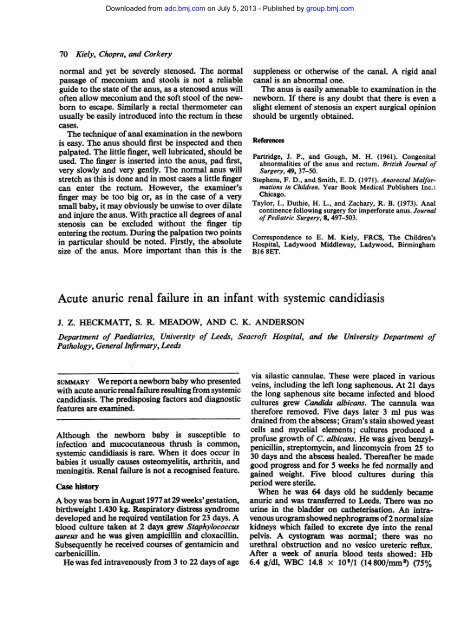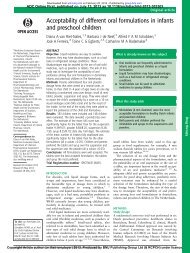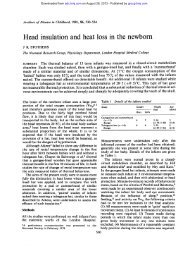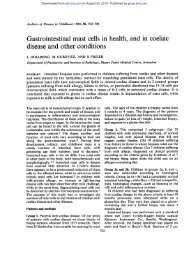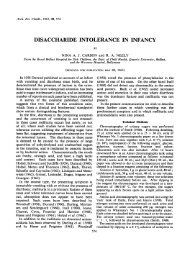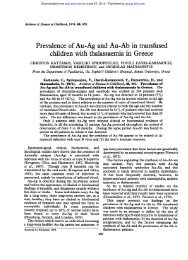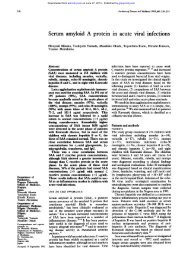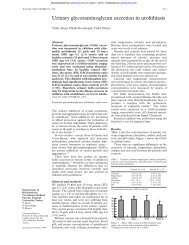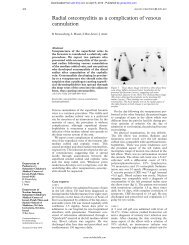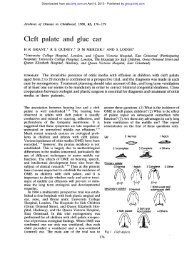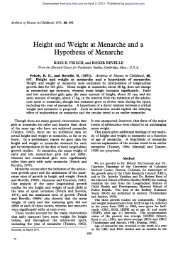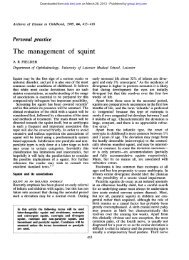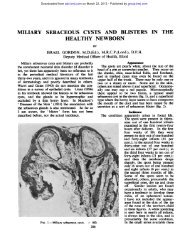Delayed diagnosis of congenital anal stenosis - Archives of Disease ...
Delayed diagnosis of congenital anal stenosis - Archives of Disease ...
Delayed diagnosis of congenital anal stenosis - Archives of Disease ...
Create successful ePaper yourself
Turn your PDF publications into a flip-book with our unique Google optimized e-Paper software.
Downloaded from<br />
adc.bmj.com on July 5, 2013 - Published by group.bmj.com<br />
70 Kiely, Chopra, and Corkery<br />
normal and yet be severely stenosed. The normal<br />
passage <strong>of</strong> meconium and stools is not a reliable<br />
guide to the state <strong>of</strong> the anus, as a stenosed anus will<br />
<strong>of</strong>ten allow meconium and the s<strong>of</strong>t stool <strong>of</strong> the newborn<br />
to escape. Similarly a rectal thermometer can<br />
usually be easily introduced into the rectum in these<br />
cases.<br />
The technique <strong>of</strong> <strong>anal</strong> examination in the newborn<br />
is easy. The anus should first be inspected and then<br />
palpated. The little finger, well lubricated, should be<br />
used. The finger is inserted into the anus, pad first,<br />
very slowly and very gently. The normal anus will<br />
stretch as this is done and in most cases a little finger<br />
can enter the rectum. However, the examiner's<br />
finger may be too big or, as in the case <strong>of</strong> a very<br />
small baby, it may obviously be unwise to over dilate<br />
and injure the anus. With practice all degrees <strong>of</strong> <strong>anal</strong><br />
<strong>stenosis</strong> can be excluded without the finger tip<br />
entering the rectum. During the palpation two points<br />
in particular should be noted. Firstly, the absolute<br />
size <strong>of</strong> the anus. More important than this is the<br />
suppleness or otherwise <strong>of</strong> the c<strong>anal</strong>. A rigid <strong>anal</strong><br />
c<strong>anal</strong> is an abnormal one.<br />
The anus is easily amenable to examination in the<br />
newborn. If there is any doubt that there is even a<br />
slight element <strong>of</strong> <strong>stenosis</strong> an expert surgical opinion<br />
should be urgently obtained.<br />
References<br />
Partridge, J. P., and Gough, M. H. (1961). Congenital<br />
abnormalities <strong>of</strong> the anus and rectum. British Journal <strong>of</strong><br />
Surgery, 49, 37-50.<br />
Stephens, F. D., and Smith, E. D. (1971). Anorectal Malformations<br />
in Children. Year Book Medical Publishers Inc.:<br />
Chicago.<br />
Taylor, I., Duthie, H. L., and Zachary, R. B. (1973). Anal<br />
continence following surgery for imperforate anus. Journal<br />
<strong>of</strong> Pediatric Surgery, 8, 497-503.<br />
Correspondence to E. M. Kiely, FRCS, The Children's<br />
Hospital, Ladywood Middleway, Ladywood, Birmingham<br />
B16 8ET.<br />
Acute anuric renal failure in an infant with systemic candidiasis<br />
J. Z. HECKMATT, S. R. MEADOW, AND C. K. ANDERSON<br />
Department <strong>of</strong> Paediatrics, University <strong>of</strong> Leeds, Seacr<strong>of</strong>t Hospital, and the University Department <strong>of</strong><br />
Pathology, General Infirmary, Leeds<br />
SUMMARY We report a newborn baby who presented<br />
with acute anuricrenal failure resulting from systemic<br />
candidiasis. The predisposing factors and diagnostic<br />
features are examined.<br />
Although the newborn baby is susceptible to<br />
infection and mucocutaneous thrush is common,<br />
systemic candidiasis is rare. When it does occur in<br />
babies it usually causes osteomyelitis, arthritis, and<br />
meningitis. Renal failure is not a recognised feature.<br />
Case history<br />
A boy was born in August 1977 at29 weeks' gestation,<br />
birthweight 1.430 kg. Respiratory distress syndrome<br />
developed and he required ventilation for 23 days. A<br />
blood culture taken at 2 days grew Staphylococcus<br />
aureus and he was given ampicillin and cloxacillin.<br />
Subsequently he received courses <strong>of</strong> gentamicin and<br />
carbenicillin.<br />
He was fed intravenously from 3 to 22 days <strong>of</strong> age<br />
via silastic cannulae. These were placed in various<br />
veins, including the left long saphenous. At 21 days<br />
the long saphenous site became infected and blood<br />
cultures grew Candida albicans. The cannula was<br />
therefore removed. Five days later 3 ml pus was<br />
drained from the abscess; Gram's stain showed yeast<br />
cells and mycelial elements; cultures produced a<br />
pr<strong>of</strong>use growth <strong>of</strong> C. albicans. He was given benzylpenicillin,<br />
streptomycin, and lincomycin from 25 to<br />
30 days and the abscess healed. Thereafter he made<br />
good progress and for 5 weeks he fed normally and<br />
gained weight. Five blood cultures during this<br />
period were sterile.<br />
When he was 64 days old he suddenly became<br />
anuric and was transferred to Leeds. There was no<br />
urine in the bladder on catheterisation. An intravenous<br />
urogram showed nephrograms <strong>of</strong>2 normal size<br />
kidneys which failed to excrete dye into the renal<br />
pelvis. A cystogram was normal; there was no<br />
urethral obstruction and no vesico ureteric reflux.<br />
After a week <strong>of</strong> anuria blood tests showed: Hb<br />
6.4 g/dl, WBC 14.8 x 109/1 (14800/mms) (75%


